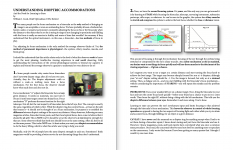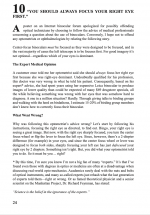Hi Maljunulo,
Relying on wikipedia.de, I believe that's the original 1855 Helmholtz explanation, which since has been expanded (1980s-ish, it seems) by identifying some muscles that support accommodation towards infinity. I believe that would imply a finite (but long) distance for relaxed focussing, but the article only mentions this aspect in passing.
It seems that once you're a bit past 50 years, accomodation is limited to 2 dpt maximum, 1dpt typical, anyway (Duane's curve, via en.wikipedia.org). On one hand, that means that you're not likely to focus your optics to a distance much different from the optimum, but on the other hand, you're probably less able to tolerate deviations, I'd speculate.
Regards,
Henning
I think the relaxed, unaccommodated (without arguing what that “means”) human eye will be focused on infinity.
A relaxed, unoccommodated eye is defined as an eye with the ciliary muscles which control the curvature of the OEM lens relaxed and in a state of zero contraction, so that the lens is at its minimum curvature.
Relying on wikipedia.de, I believe that's the original 1855 Helmholtz explanation, which since has been expanded (1980s-ish, it seems) by identifying some muscles that support accommodation towards infinity. I believe that would imply a finite (but long) distance for relaxed focussing, but the article only mentions this aspect in passing.
It seems that once you're a bit past 50 years, accomodation is limited to 2 dpt maximum, 1dpt typical, anyway (Duane's curve, via en.wikipedia.org). On one hand, that means that you're not likely to focus your optics to a distance much different from the optimum, but on the other hand, you're probably less able to tolerate deviations, I'd speculate.
Regards,
Henning








